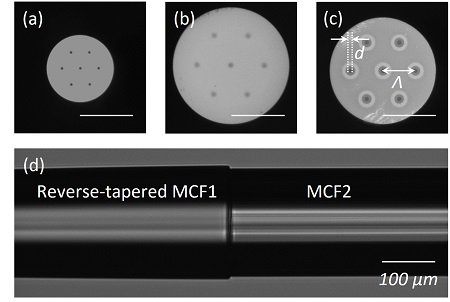Researchers at Fudan University demonstrated low-loss fusion splicing techniques between spacing-mismatched multicore fibers (MCFs). According to the researchers, the work builds on previous studies — including from other research groups — that addressed the challenge of multicore splicing but did not address MCF splicing with any mismatched spacings.
Multicore fibers offer numerous advantages over single-core design, in transmission capacity, space saving integration, and the ability to eliminate cross-sensitivity. By these merits, the technology demonstrates a range of potential applications, but it is hindered by a lack of manufacturing standards.
“For dissimilar MCFs with different core-to-core spacings, the alignment of the space location of each core is a general challenge,” Limin Xiao, a professor in Fudan University’s School of Information Science and Technology and Yiwu Research Institute, told Photonics Media. According to Xiao, who is the corresponding author on the researchers’ paper, some members of the team think that splicing dissimilar MCFs is impossible and will ultimately hinder widespread application of the technology.
Two factors judge the quality of an MCF splice: the splicing loss of each core and the crosstalk between different cores after the splicing. These are different from a conventional fiber splice, considering splicing loss only, Xiao said. “Therefore, the challenge of splicing dissimilar MCFs is to achieve the matching of the core-to-core spacing, the matching of mode field diameter (MFD) of each core, and avoid the crosstalk of each core at the splicing joint simultaneously,” Xiao said.
The researchers proposed using a tapering technique to reshape and splice MCFs to tailor the spacing and modify the modal property of MCFs.

Fig.1 shows cross sections and a fusion splice between two dissimilar MCFs: (a-c) Cross-sections of (a) MCF1, (b) reverse-tapered MCF1, and (c) MCF2; and (d) splicing joint of the reverse-tapered MCF1 and MCF2 at the same scale. Courtesy of Limin Xiao/Optics Letters.
“To the best of our knowledge, the first reverse tapered MCF was demonstrated in this paper,” Xiao said.
Tapered optical fibers are achieved by heating the fiber and then stretching it, or conversely, in the case of the reverse tapered fiber, compressing the fiber. Such an effect makes the fiber thinner or larger over the length of a few millimeters or a few centimeters, with the fiber core and core-to-core spacing following suit.
“Generally, a tapered optical fiber can be fabricated by stretching an optical fiber when it is heated over a flame, such that the heated glass becomes soft; this procedure makes the fiber thinner over some length — maybe a few millimeters or centimeters,” Xiao said. “The fiber core also becomes thinner in the same factor as the total fiber. For MCFs, the core-to-core spacing will become smaller in the same factor as well when implementing this down-tapering process. Conversely, the reverse tapered fiber can be made by compressing an optical fiber when it is heating. When reverse-tapering MCFs, the core and core-to-core spacing will become larger in the same factor of the reverse-tapering ratio.”
Xiao added that the increased value of the MFD of the MCF is much less than the increase of the core-to-core spacing during reverse tapering — which will not induce extra crosstalk for adjacent core — and it is the fundamental advantage of the described technique. The method of down tapering may reduce the splicing quality, or increase crosstalk, of MCFs, and reverse tapered MCFs overcome this issue.
By matching both the spacing and the mode size, the researchers demonstrated a low-loss and low-crosstalk fusion splice between two spacing-mismatched MCFs. They achieved an average splicing loss of 0.18 dB and −68 dB of crosstalk for the splice between two significantly spacing-mismatched MCFs, with a spacing difference of 26 µm. For the splice between two slightly spacing-mismatched MCFs, with a difference of 5 µm, the team achieved an average splicing loss of 0.17 dB and crosstalk of −66 dB.
The researchers expect that the techniques will enable MCF device fabrication and boost various MCF applications.
“The specific application example of a low-loss fusion splice between dissimilar MCFs that we would expect is MCF amplification construction,” Xiao said. “The erbium-doped cores of MCF generally have a high numerical aperture and relatively small core. Our technique will directly benefit this application.”
According to the research team, the technique overcomes multiple, distinct bottlenecks in that it resolves an architectural challenge to fiber design and, as a result, aims to resolve the issue of high demand stemming from suitable MCF splicing methods that influences the ability to make an effective connection for datacom and telecom applications.
“As we know, MCFs possess the advantages of high-density multichannel, low production cost per channel, space-saving integration, and high transmission capacity. However, the lack of suitable MCF splicing technique will limit the freedom of fiber design and increase the demand of high precision fabrication with low tolerance,” Xiao said. “In other words, all the MCFs must possess the same core-to-core spacing for effective connection. We believe that our technique will release the full potential of MCFs in different circumstances.”
The research was published in Optics Letters (www.doi.org/10.1364/OL.447602).